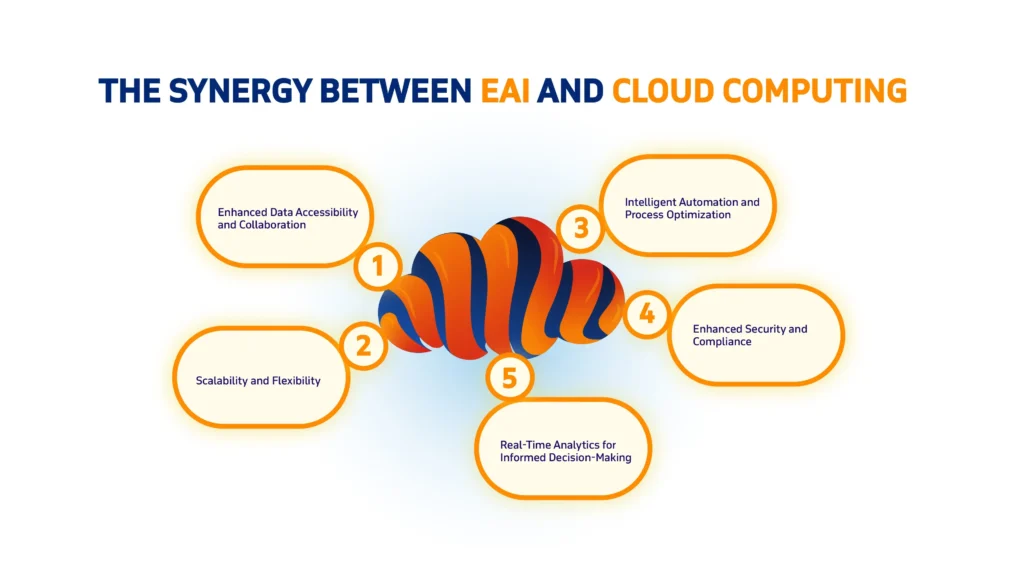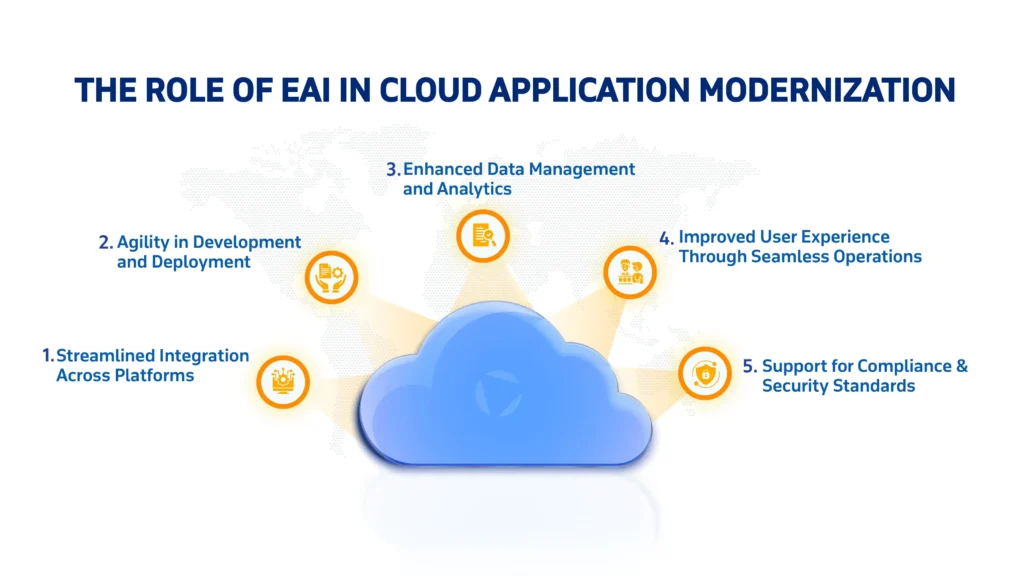Transform Your Business: The Power of EAI and Cloud Computing in 2025
Author: Laila Meraj
16 January, 2025
The convergence of Enterprise Application Integration (EAI) and cloud computing is set to redefine business operations in 2025. As organizations increasingly seek agility, scalability, and efficiency, the integration of these two powerful technologies presents a unique opportunity for transformation. This blog will explore how EAI and cloud computing work together to revolutionize business processes, enhance customer experiences, and drive innovation.

The Synergy Between EAI and Cloud Computing
EAI facilitates seamless communication between disparate applications within an organization. By integrating these applications, businesses can streamline workflows, reduce redundancy, and improve data accuracy. When combined with cloud computing, which offers scalable resources and flexible deployment options, the potential for transformation becomes even greater.

1. Enhanced Data Accessibility and Collaboration
Cloud computing provides a centralized platform where data from various applications can be stored and accessed. This accessibility is crucial for organizations that rely on multiple systems to operate efficiently. With EAI in place, businesses can ensure that data flows smoothly between these systems, enabling real-time collaboration among teams.
For instance, a company using cloud-based managed services can integrate its customer relationship management (CRM) system with its enterprise resource planning (ERP) software. This integration allows sales teams to access inventory levels in real-time, improving decision-making and customer service.
2. Scalability and Flexibility
One of the significant advantages of cloud computing is its scalability. Businesses can easily adjust their resources based on demand without investing in physical infrastructure. Coupled with EAI, this flexibility allows organizations to quickly adapt to changing market conditions.
As businesses grow or pivot their strategies, they can implement cloud migration services to transition their existing applications to the cloud seamlessly. This transition is often facilitated by cloud migration consulting services that guide organizations through the process of integrating their legacy systems with modern cloud solutions.
3. Intelligent Automation and Process Optimization
The integration of EAI with cloud computing enables businesses to implement intelligent automation across their operations. By utilizing cloud-based tools that support automation, organizations can streamline repetitive tasks and reduce human error. For example, automated workflows can be established that trigger actions in one application based on events in another, enhancing overall process efficiency.
This synergy allows for more sophisticated process optimization, where data from various applications is analyzed to identify bottlenecks or inefficiencies. As a result, businesses can continuously refine their operations, leading to improved productivity and cost savings.
4. Enhanced Security and Compliance
With the increasing importance of data security and regulatory compliance, the combination of EAI and cloud computing offers strong solutions. Cloud providers often implement advanced security measures, such as encryption and access controls, which can be integrated with EAI frameworks to ensure that sensitive data remains protected during transmission between applications.
Moreover, businesses can leverage cloud-based compliance tools that automatically monitor and report on regulatory adherence across integrated systems. This proactive approach not only mitigates risks but also enhances trust with customers and stakeholders.
5. Real-Time Analytics for Informed Decision-Making
The synergy between EAI and cloud computing facilitates real-time analytics capabilities that empower organizations to make data-driven decisions swiftly. By integrating analytics tools within the cloud infrastructure, businesses can analyze data from multiple sources in real time.
This capability allows for immediate insights into operational performance, customer behavior, and market trends. For instance, a retail company could use real-time analytics to adjust inventory levels based on current sales data pulled from its CRM and ERP systems integrated through EAI. This responsiveness can significantly enhance competitive advantage in fast-paced markets.
These additional points further illustrate how the integration of EAI and cloud computing not only streamlines operations but also enhances security, compliance, and decision-making capabilities within organizations.
The Role of Artificial Intelligence in EAI and Cloud Computing
Artificial intelligence (AI) plays a pivotal role in enhancing the capabilities of both EAI and cloud computing. By leveraging AI technologies such as machine learning and predictive analytics, businesses can gain deeper insights into their operations and customer behaviors.
1. Intelligent Automation
AI can automate repetitive tasks within integrated applications, freeing up valuable human resources for more strategic initiatives. For example, AI-driven chatbots can handle customer inquiries across various platforms integrated through EAI, providing instant responses while collecting valuable data for future interactions.
This level of automation not only improves operational efficiency but also enhances customer satisfaction by providing timely support.
2. Predictive Analytics for Better Decision-Making
With the integration of AI into cloud-based services, businesses can utilize predictive analytics to forecast trends and make informed decisions. By analyzing historical data from integrated applications, organizations can identify patterns that inform strategic planning.
For instance, a retail company could analyze sales data from its e-commerce platform alongside inventory levels from its ERP system to predict demand for specific products during peak seasons.
The Role of EAI in Cloud Application Modernization
As businesses embark on their journey of digital transformation in 2025, the role of Enterprise Application Integration (EAI) becomes increasingly vital in the context of cloud application modernization. This process not only involves updating legacy applications to leverage modern cloud capabilities but also ensuring that these applications integrate seamlessly with existing systems. Here are key aspects highlighting the importance of EAI in cloud application modernization:

1. Streamlined Integration Across Platforms
EAI enables organizations to integrate various applications and data sources, creating a cohesive ecosystem that enhances operational efficiency. When modernizing applications, businesses often encounter multiple platforms and systems that need to work together. EAI facilitates this by providing a framework for connecting disparate systems, ensuring that data flows smoothly between them.
For instance, a manufacturing company modernizing its inventory management system can utilize EAI to integrate this system with its platform and customer relationship management (CRM) software. This integration allows for real-time updates on inventory levels, improving order fulfillment and customer satisfaction.
2. Agility in Development and Deployment
The integration capabilities provided by EAI allow businesses to adopt agile development practices during the modernization process. By enabling continuous integration and continuous deployment (CI/CD) pipelines, EAI supports rapid development cycles and faster time-to-market for new features and applications.
This agility is particularly important as businesses need to respond quickly to market changes and customer demands. With EAI, organizations can implement updates and enhancements without disrupting existing workflows, thereby maintaining operational continuity while modernizing their applications.
3. Enhanced Data Management and Analytics
Modern cloud environments generate vast amounts of data from various sources. EAI plays a crucial role in managing this data effectively by ensuring that it is collected, processed, and analyzed across integrated systems. By leveraging cloud-based analytics tools, organizations can gain valuable insights from their data, driving informed decision-making.
For example, a healthcare provider modernizing its patient management system can use EAI to integrate electronic health records (EHR) with analytics platforms. This integration allows healthcare professionals to access comprehensive patient data in real-time, improving care quality and operational efficiency.
4. Improved User Experience Through Seamless Operations
EAI enhances user experience by ensuring that applications work together seamlessly. When users interact with modernized applications, they expect a smooth experience without interruptions or data silos. By integrating various systems through EAI, businesses can provide users with a unified interface that simplifies their interactions.
For instance, a financial institution modernizing its online banking platform can utilize EAI to integrate account management, transaction processing, and customer support systems. This integration allows customers to access all necessary services from a single platform, improving satisfaction and engagement.
5. Support for Compliance and Security Standards
As organizations modernize their applications in the cloud, compliance with industry regulations becomes paramount. EAI assists in maintaining compliance by ensuring that data is handled according to regulatory standards across integrated systems. By automating compliance checks and reporting through integrated workflows, businesses can mitigate risks associated with data breaches or non-compliance.
Also, EAI enhances security by enabling centralized control over data access and permissions across integrated applications. This centralized approach helps protect sensitive information while ensuring that only authorized personnel can access critical systems.
In summary, EAI serves as a foundational element in cloud application modernization efforts by streamlining integration, enhancing agility, improving data management, elevating user experiences, and supporting compliance requirements. As businesses continue to evolve in 2025 and beyond, leveraging EAI alongside cloud technologies will be essential for achieving sustainable growth and innovation.
Cloud Application Modernization: A Pathway to Transformation
As businesses embrace digital transformation in 2025, cloud application modernization will be a critical focus area. This process involves updating legacy applications to take advantage of modern cloud capabilities while ensuring they integrate seamlessly with existing systems through EAI.
1. Improved Performance and User Experience
Modernizing applications hosted on cloud platforms enhances their performance by leveraging advanced infrastructure capabilities such as elastic scaling and improved security features. Additionally, users benefit from enhanced interfaces and functionalities that improve overall experience.
By working with a reputable cloud solutions provider like Xorbix Technologies, organizations can ensure that their application modernization efforts align with their business goals while maintaining integration across all platforms.
2. Cost Efficiency
Transitioning to modern cloud-based architectures often leads to significant cost savings for businesses. By utilizing cloud-based desktop solutions or virtual desktop clouds, organizations can reduce hardware costs while providing employees with flexible access to necessary tools from any location.
This cost efficiency is further amplified when combined with effective EAI strategies that minimize redundancy and streamline operations across integrated systems.
The Advantages of Hybrid Cloud Solutions
In 2025, hybrid cloud solutions will become increasingly popular as businesses seek the best of both worlds, combining public and private clouds for optimal performance and security. This approach allows organizations to maintain sensitive data on private clouds while leveraging public clouds for scalability.
Enhanced Security and Compliance:
By adopting a hybrid cloud model supported by strong EAI frameworks, businesses can better manage sensitive information while ensuring compliance with industry regulations. For example, healthcare organizations can store patient records securely on private clouds while using public clouds for less sensitive operations like billing or appointment scheduling.
Increased Agility:
The ability to switch between public and private resources enables businesses to respond quickly to changing demands without compromising security or performance. This agility is crucial in today’s fast-paced business environment where adaptability is key to staying competitive.
Conclusion
As we look ahead to 2025, the integration of EAI and cloud computing will undoubtedly transform how businesses operate. By leveraging the strengths of both technologies, enhanced collaboration, intelligent automation, predictive analytics, application modernization, and hybrid solutions, organizations can navigate the complexities of digital transformation effectively.
Xorbix Technologies stands ready to support your journey towards this transformation with tailored solutions in artificial intelligence development, software services, Databricks services, and more.
Read more related to this blog:




